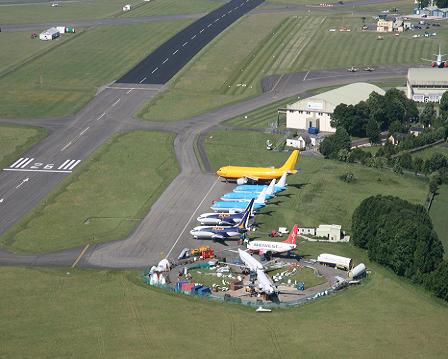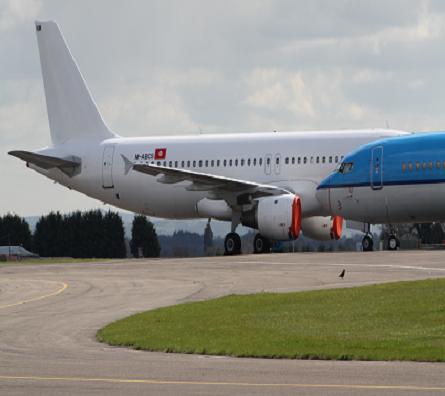Eyebrows were raised when an 11-year-old Boeing 737-600 was sold for parting out earlier this year. More worrisome for the market was the disassembly of a two-year old Ryanair 737-800 that had been damaged in a landing accident.
Most airliners are destined to end their days in the scrapyard, but these were the first disassemblies of 737 Next Generation aircraft, an in-production type that entered service as recently as 1997.
Both these twinjets were inducted by aircraft recycling and dismantling specialist Air Salvage International (ASI) at its facility at Kemble airfield in the UK, which is also known as Cotswold airport.
The Ryanair aircraft suffered a multiple bird-strike when landing at Rome Ciampino airport in November 2008. Although it landed safely, the undercarriage was badly damaged. ASI's managing director Mark Gregory says that the jet was dismantled in Rome and parts have been ferried back to the Kemble facility by road.
So while it was apparently an insurance-based decision to retire the 737-800, the scrapping of the 737-600 - which is the smallest and least popular member of the twinjet family - was driven by economics. There are currently just 68 -600s in service.
Last year saw the first parting out of an ex-Frontier Airbus A318, the newest A320 family variant that entered service as recently as 2003 and which has a similar fleet size to the 737-600, with just 72 in operation.
|
|---|
Aircraft waiting for break-up at Kemble airport in the UK
There is a range of aircraft becoming increasingly expensive to operate in the current economic environment and owners are reaching the conclusion that parting them out generates more than keeping them in operation through a lease contract.
The International Bureau of Aviation (IBA) handled the sale of the 737-600, which belonged to the administrators of defunct carrier FlyGlobespan. It had originally been delivered to Scandinavian Airlines.
|
|---|
Midwest's 737-600 was the second NG to be disassembled after a Ryanair 737-800 (seeing here in the background)
"We were surprised by the amount of bidders, mainly tear-down companies," says IBA's commercial director Owen Geach.
"The failure of FlyGlobespan presented some interesting remarketing projects. With the 737-600 having an operating base that remains all too dominated by Air Algerie, Malév, SAS, Tunisair and WestJet, it seemed apparent that other avenues had to be explored. Part-out to realise the value in the engines and airframe was too tempting," Geach adds.
Flightglobal's ACAS database lists 2,340 jet airliners as being permanently retired over the past 10 years with 70% being narrowbodies.
IBA conservatively forecasts that more than 3,500 aircraft will be parked across the 10-year span. The bureau expects an estimated 1,500 parked aircraft to come from the North American fleets, while it believes that European aircraft will total 810 units.
"You will see an increasing number of MD-80s, 737s, 757s and A320s heading for part-out as they get replaced by newer-technology aircraft," says Geach.
While the 737-600/800 disassemblies could be one-off transactions, just as the first A318 part-out last year, more ageing A320s are due to head to the scrapyard.
The appraiser and consultancy firm says that between 10 and 14 A320 aircraft a year will be part-out candidates over the next five years. Among them are the older aircraft operated by major European carriers such as Air France, British Airways and Iberia.
|
|---|
Nouvelair's A320-200 is being dismantled along with three KLM 737-400s at Kemble
While the airlines business is cyclical, the dismantling and recycling has been one of the few booming sectors of the aviation industry. For Gregory, breaking up an aircraft is the owner's last resort. "Obviously owners would rather see their aircraft in the skies," he says, adding that economics push them to look at "other alternatives".
Inevitably aircraft reach an age at which airlines find them too old and inefficient to be operated cost-effectively.
"When looking at selling or leasing aircraft, you have to consider age restrictions in some countries," points out IBA. "The 20-year rule in some countries, such as the Middle East, or 15-year Chinese or Russian cap can influence part-out decisions."
Age is a major consideration, but IBA points out that the engine condition is a key element in the aircraft owner's final decision. While aircraft seats, television screens and reading lights can be sold at almost no cost, the value is more in the engines, landing gear and avionics.
IBA adds that attracting financing for used aircraft is rare. "There is a paradox at the moment. Many airlines don't have the financial strength to purchase new aircraft and refinancing older aircraft is difficult." In many cases selling an aircraft is the best option.
Spares demand
In addition, demand for spares has grown for engine parts as operators see opportunities to keep aircraft on wing longer, without sending engines through a shop visit. IBA also notes a significant interest from engine traders rather than placing orders with engine manufacturers for spare engines.
Figures produced by IBA provide evidence of a fall in prices for passenger aircraft. A 20-year-old A320 has a market value of $8.3 million, says IBA, 20% down on the $10.3 million it was worth a year ago. However, for the tear-down market the aircraft will probably be sold for between $6 million and $7 million according to the firm. Of this, the part-out companies will probably receive between $1.5 million and $2 million per engine.
IBA says the 737 Classic is more affected than the A320 mode as its market is plummeting. A 20-year-old 737-400 now has a market value of $5.5 million, but in the tear-down market the value would drop to $3 million.
The 737 Classic makes up the bulk of the aircraft meeting their end at Kemble, notably three ex-KLM twinjets as well as two ex-KD Avia aircraft at different stages of part-out.
But this year will see more A320s joining the field, predicts Gregory. "The A320 market is a growing business for us," he says.
Over the past two years the company has dismantled six aircraft of the type. This year, ASI is dismantling two ex-Air France and one ex-Nouvelair Tunisie aircraft and has two more scheduled to arrive.
On an average good year, the company dismantles 20 aircraft. In 2009, ASI parted out 25 aircraft, but Gregory believes that this year that total will reach 30.
The paradox is that ASI had more aircraft to break up but fewer parts are being taken out.
According to Gregory, 80% of an A320 can be reused in the market place. On a typical Classic, the company would have taken out 1,500 line replaceable units five years ago. Today, the same aircraft will only need 300 items out. "The list has shrunk along with the market requirement. Fewer parts are required by operators and most of these aircraft end up for scrap," he says.
Gregory says that only 60% of Classic aircraft are now being recycled. "The popularity of the Classics in the current market is not great and the longer owners wait, the less they tend to get."
The 737-600 dismantling should be completed by the end of July.
Gregory believes that as many as 1,800 parts will be taken out of the aircraft because the secondhand market for the 737-600 model is limited. "The cabin interior will probably be used again," he adds.
Source: Commercial Aviation Online



















